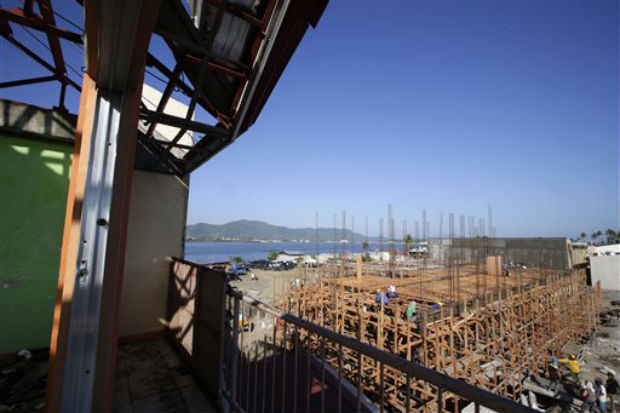UN notes change year after ‘Yolanda’

A building is constructed from a village which was almost totally wiped out by Super Typhoon “Yolanda” (Haiyan) last year in Tacloban City on Nov.7, 2014. When the UNDP Asia-Pacific director, Haoliang Xu, returned to typhoon-ravaged Eastern Visayas last weekend, he noticed not just the buildings and homes that have risen again. He also saw the lives rebuilt a year after Super Typhoon “Yolanda” smashed through the region. AP
MANILA, Philippines–When the United Nations Development Program (UNDP) Asia-Pacific director returned to typhoon-ravaged Eastern Visayas last weekend, he noticed not just the buildings and homes that have risen again. He also saw the lives rebuilt a year after Super Typhoon “Yolanda” smashed through the region.
Haoliang Xu, the UNDP’s assistant administrator and regional director for Asia and the Pacific, saw the “enormous” recovery when he visited Tacloban and Palo in Leyte province, among the worst-hit areas when Yolanda (international name: Haiyan) struck on Nov. 8, 2013.
“Of course, the scars of the disaster are still there, it’s not as if everything is perfect,” Xu told the Inquirer. “The scars are still visible but the changes are enormous.”
“Buildings have been repaired, businesses have opened. Life has come back, not fully to normal, but you can see that a lot has come back,” he said in an interview on Monday, the eve of his departure after an eight-day visit.
From the air and on the ground, Xu saw how far the affected communities had come a year since they lost their loved ones and most of what they had.
Xu first visited the disaster zone on Nov. 22 last year—14 days after the typhoon struck.
“I took many aerial photos last year, I flew on a helicopter because there were no other means of transportation … This time, I took a regular flight, I tried to take aerial photos as well. Putting them together, you see the difference,” said Xu, who is based at the UN headquarters in New York.
He also saw how the people he had met had recovered.
Very impressed
“I was very impressed to see the changes … I don’t see the kind of despair at all, I don’t see the kind of sadness now. You can see the high spirits. People want to move on. It’s totally different.”
Xu was briefed about the government’s recovery plan and hoped it could be fully implemented.
“The hope is not just to build back but to build back better in a sustainable way, meaning you need to strengthen social services, social protection so that people who are poor have something to fall back on,” Hu said.
As the nation faced the process of recovery, Xu said “managing people’s expectations” was the biggest challenge for the government and its development partners.
“There are still residual humanitarian needs left but now people want to move on,” he said. “They want longer-term permanent shelters. They want livelihood … That’s the biggest challenge for all of us—how can we meet the expectations realistically because reconstruction and recovery will take time.”
‘Right expectations’
Some survivors have expressed disappointment over the pace of recovery. Yolanda displaced four million people and affected half of the country’s provinces.
“I think there are always people who would want more. Because when the wait for transitional shelter is too long, I think we need to see things from their point of view,” Xu said.
He urged the government to communicate its targets and achievements to survivors so they would know “what they can expect.”
“You have to let people know so that they have the right expectations,” Xu said.
He proposed a monitoring system where the survivors themselves could get involved and report if they see progress.
“There are many good practices elsewhere where we ask beneficiaries to take a photo of the projects and post it online and say, ‘This is what I saw today,’ ‘in 20 days this is the progress I saw,’ or ‘in 20 days I have not seen progress,’” said Xu, citing the experience in other countries.
This would spare those involved in reconstruction from wasting time “in unnecessary arguments,” he said.